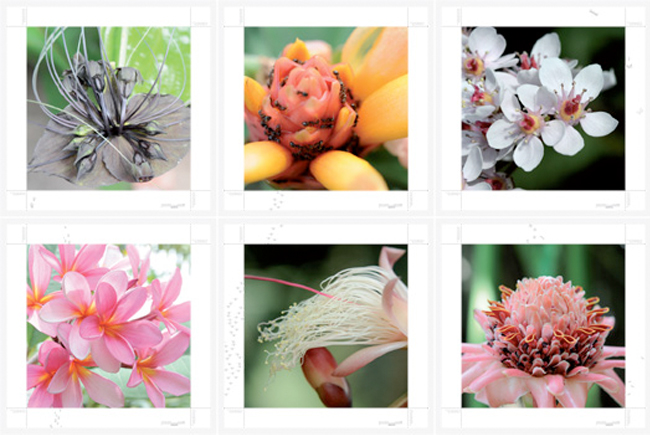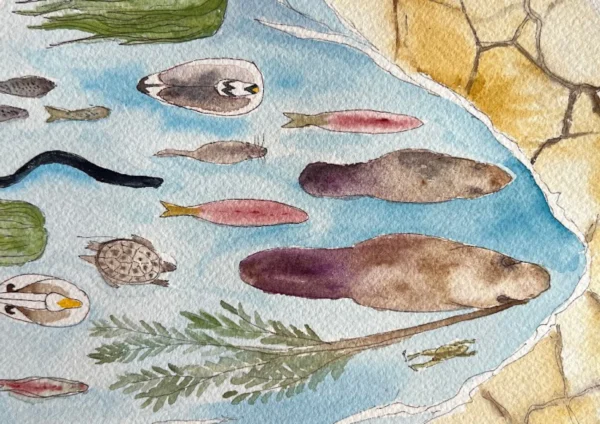
Exposition Météo des forêts
Entre constat des impacts de la crise climatique en cours et possibilité de résilience, l’exposition Météo des forêts propose des…

6 october – 12 December 2010
Natural History Museum London
Solo Exhibition
Materials:Lambda photographs backed on Dibond. Dimensions: Framed 128 x 128 x 5cm each
Concept:During the expedition to the Peruvian Amazon in 2009, Lucy + Jorge travelled with scientists from the Environmental Change Institute (ECI) at Oxford University. Together they mapped out a one-hectare plot in the rainforest. Trees and rare plants were marked for data collection and statistics on the types of botanical species were registered for scientific research programmes. This first-hand experience moved the artists to create Perpetual Amazonia – one of the key artworks in the series Amazonia – so that this hectare of land could be conserved in perpetuity, dedicated to scientific research and for the benefits we all receive from long-term forest conservation.
The plot at GPS coordinates S12 48 21.6 W71 24 17.6 is in the heart of the Fundo Mascoitania a 600-hectare private property managed by the CREES Foundation and protected by Peruvian law. The area is encompassed within the cultural zone of the Manú Biosphere Reserve. The reserve constitutes the largest protected area in Peru and has various levels of protection with the Manu National Park being a UNESCO World Heritage site.
Perpetual Amazonia comprises of a series of original photographs from plant species all over the world. Each photograph represents a single square metre within the one-hectare (10,000sqm), and is marked with the Universal Transverse Mercator (UTM) coordinates. On acquiring a photograph the purchaser will receive a one-metre ‘stake’ in the rainforest and a percentage of the sales price will be sent to the scientific research programmes taking place in MANU. The artists hope that the participative artwork will help us understand the value of nature and that loss of nature also comes at a value.
“Perpetual Amazonia can help us understand the need to conserve forests and wildlife all over the world. As one of the lungs of the planet, forests help us to breathe.” Lucy Orta
“Today, conservation efforts are increasingly guided by the value of nature in ways that can be understood by economists, politicians and financial markets – as another way to counteract the accelerated destruction of biodiversity. This means placing a monetary value, thereby a tradable value, on public goods services that our natural environment provides, such as clean air, fresh water, fertile soil, drought and flood prevention, resistance to erosion, provision of nursery grounds and so on. This language of economic currency, advocating the monitoring of nature and ecological modernisation, may be another way to prevent the increasing rate of the depreciation of our natural assets or indeed the rapid rate of extinction of species across the globe. Moreover, the relationship between biodiversity loss, climate change and sustainable development for people needs to be transformed into a financial mechanism towards preserving ecosystems. Environment and economy have become intrinsically linked.
One mechanism operating at an intergovernmental level is REDD (Reduced Emission from Deforestation and Degradation) trading scheme. This enables governments to measure their country’s carbon dioxide production from fossil fuel use and to offset their pollution by protecting forests from degradation. In other words, the carbon locked in the forest remains in place and the forest continues to recover carbon dioxide from its atmosphere through photosynthesis. While the REDD trading mechanism is designed to account for the carbon capture that is achieved by investing in the forest, in REDD+ the programme has been developed further and goes beyond deforestation and forest degradation. The plus symbolises all the other values of the forest that are retained by protecting it – clean water, nutrient provisions for soils downstream, food, fuel and other products from the forest for local people, or the potential novel chemical that might form the basis for future medicines and other products.
Today the Amazon region is also regarded as a potential tipping point – where systems may collapse. This would have a major impact not only locally, but also on a much wider area, because of the forest’s influence on regional and global climates. Our understanding of nature needs to be global; no environment can be seen in isolation. The Amazon region may be many travel hours away from Europe but our influence on climates and biodiversity starts in our daily lives in the consumer choices we make.” Bergit Arends curator of contemporary art at the Natural History Museum London.
Entre constat des impacts de la crise climatique en cours et possibilité de résilience, l’exposition Météo des forêts propose des…
Une exposition qui explore les liens entre Deep Listening et écologie, dans le nouvel espace de la Fondation Pernod Ricard,…
Exposition sur le lien environnemental entre la rivière et le castor à l'Artothèque, Espaces d'art contemporain, Caen

